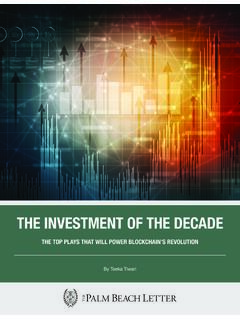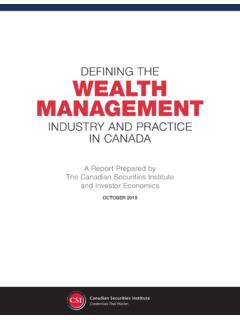Transcription of THE DA VINCI FACTOR - scdn.palmbeachgroup.com
1 THE DA VINCI FACTORBy Teeka TiwariHOW TO BEAT THE STOCK MARKET BY 3X WITH UNTOUCHABLE you may have noticed, the collectibles market is booming right , a LeBron James rookie basketball card sold for $ $5 (yes, $5) 1822 half-eagle gold coin was snatched by a collector for $ , get new form of collectible 100% digital just sold at an auction for a staggering $69 reports the market for these digital collectibles has absolutely exploded 1,785% since despite this new boom, few people know about a special category of Untouchable collectibles that the super-rich are pouring their money into. They ve been tucking away a good chunk of their wealth 5% on average in a place that s traditionally been way out of reach for regular m talking about rare fine centuries, in fact, the rich have used art to grow their fortunes and increase their example, did you know wealthy investors in Renaissance Italy were the driving force behind some of history s most iconic masterpieces?
2 Take Da VINCI s Savior of the World (pictured at right)..This painting once sold at an auction in 1958 for just $72 was recently snatched up by a Saudi billionaire for a staggering $450 million, according to $72 to $450 million. That translates into a 624,999,900% gain. Of course, not every painting is a Da VINCI or a Van and that increase happened over a very long period of so you can t expect these kinds of numbers every time. However, over the last 25 years, fine art from famous contemporary painters has consistently beaten the stock market by nearly s a huge difference. Three times better than stocks. Even in a record bull DA VINCI FACTORHOW TO BEAT THE STOCK MARKET BY 3X WITH UNTOUCHABLE COLLECTIBLESBy Teeka Tiwari and Nilus art can also act as another way to bulletproof your portfolio. Since 1995, it s trounced other conventional safety hedge investments like gold and real estate , which have returned 366% and 195%, respectively.
3 And it s done so with very little the BBC put it:Paintings can go up in value even when the stock market crashes, making it a good diversification for an investment you see now why adding a bit of art to your portfolio makes sense especially in today s volatile market?That s why the super-rich are flocking to art today in droves. But because of how pricey art is, for decades ordinary Americans have been locked out of this lucrative recently found a but incredibly smart for everyday Americans to invest in fine art starting with very little s all thanks to the JOBS Act, which was signed into law in 2012. Essentially, the JOBS Act tore down the wall between the super-rich and ordinary And opened up investment opportunities that were previously reserved only for the upper including the specific opportunity we want to tell you about today.
4 For instance, it includes a provision that created an exemption under federal law allowing companies to sell securities to the public via crowdfunding. Crowdfunding is a way for organizations to raise funds online for a specific cause from even millions of crowdfunding, ordinary people can also pool their money and invest in everything from classic cars to real estate projects (or fine art) just as the heavy-hitters have been doing for years. In the past, you d need to be a millionaire to get in on these kinds of opportunities. But thanks to the JOBS Act, everyday investors can invest in collectibles and rare art just like the wealthy. And it s as simple as buying me the stock market, when you buy shares of a company like Coca or Tesla, you own a piece of that the platform we re recommending, you can buy a share of art by someone like Andy Warhol or Claude you can get started from your phone or computer with as little as $ vs.
5 S&P 500 Returns5x025x20x15x10xOver the past 25 years, post-war and contemporary art have nearly tripled the S&P 500's returnsSource: MasterworksPost-War & Contemporary ArtS&P 500 (includes dividends) investors have already been cashing including a booked annualized return of 32% in one year from a Banksy painting called Mona Lisa (pictured below).That profit was twice the return from the S&P 500 over the same time , you can t go back and participate in that deal now. And there s never a guarantee that the same type of opportunity will happen we believe putting a small portion of your investment portfolio into these opportunities just like the super-rich will go a long way in the coming months and report will show you exactly how to use this unique platform to get fractional ownership in some of the world s most desirable paintings with as little as $20.
6 Better yet, as you ll see, it isn t just a buy-and-hold arrangement. This special platform also gives you the ability to trade fractional positions at any time you like (and without paying any commissions).Best of all, through a special arrangement, we ve managed to secure guaranteed access for you through an exclusive head of the line pass. It allows you to skip ahead of the 30,000-plus people currently waiting to sign up for the we get into the You Should Add Some High-End Artwork to Your Portfolio Right NowAccording to Sotheby s Institute of Art, In the 1960s, the idea of art as investment took hold and prospered into the $64 billion art market of today. That number represents the total value of high-end art changing hands on an annual basis. About half of those transactions happen publicly through , if you look at the total value of all the high-end art in the world essentially, the market cap of the art market the number swells to roughly $ chart below shows how that stacks up against other private asset you can see, the fine art market is roughly half the size of the private equity market.
7 Worth individuals are already taking advantage, allocating an average of 5% of their money to the category. In fact, according to the Knight Frank Global Wealth Report, 37% of individuals worth at least $30 million actively collect or own fine art. Meanwhile, the CEO of BlackRock, the world s largest asset manager, says contemporary art is one of the greatest stores of wealth right for good High-end art isn t just a separate asset class from more traditional investment categories like stocks, bonds, and real it is superior in some ways. Here are just some of the advantages it can bring to your Outperformance: As mentioned earlier, post-war and contemporary art have outperformed the S&P 500 almost three times over since alone makes it a compelling addition to any investor s portfolio. But that s not the only Stable returns: Art s worst stretch was in 2008 2009.
8 While the S&P fell 57% peak to trough, auction prices on art declined only 27%. According to the Deloitte and ArtTactic 2016 Art & Finance Report, art has historically been 40% less volatile than the S&P 500. Deutsche Bank reported 2018 was the worst year for asset classes since 1920. Ninety percent of the 70 asset classes tracked by the investment bank were down. Per The Wall Street Journal, art was the top-performing asset class, up Low correlations: Over the last four decades, art has had almost no correlation to other asset classes. That means its performance doesn t mirror the performance of other types of investments. A correlation of 1 means two different assets move in lockstep. Art s low correlations to other popular investments, like the 10-year Treasury ( ), the S&P 500 ( ), gold ( ), private equity ( ), and real estate ( ), make it a good tool for diversification.
9 Scarcity: When it comes to fine art, the total supply is extremely limited. Especially if you start talking about a particular artist s body of work. What s more, as more of these paintings find their way into the permanent collections of museums and other public entities, the supply continues to decline. Tangible, mobile, and international: A painting is a real , tangible asset like a piece of prime real estate . However, unlike a house or land, you can transport and you can sell it anywhere in the world in any currency. Roughly, 64% of fine art assets are outside of the United States right all of these advantages, it isn t surprising that art continued to outperform during the COVID to Citibank s Global Art Market and COVID-19 report, contemporary art outperformed the 10 major asset classes during the first seven months of 2020 with a gain versus losses in most other categories.
10 The larger art category also delivered a positive return of a world of unprecedented money-printing and ultra-low interest rates, it is extremely likely that wealthy investors will continue to put more of their money into trophy assets like the world s best paintings. And now, after centuries of remaining exclusively the filthy rich, you can finally get access to the very same artwork and all of the related investment Masterworks: Making Blue-Chip Art Accessible to EveryoneIn 2017, Scott Lynn launched the Masterworks platform to make blue-chip artwork investable for everyone. It s the first company to take blue-chip paintings public by filing them with the SEC. Lynn s personal Abstract Expressionism collection had realized gains of per year. He launched Masterworks as a way of giving other investors the chance to earn outsized profits from art as he told us, The goal is to bring investment-grade paintings to the platform that drive superior returns.











